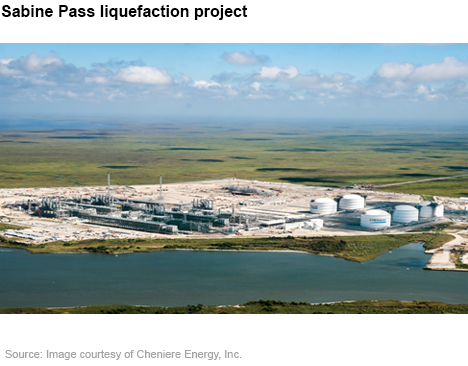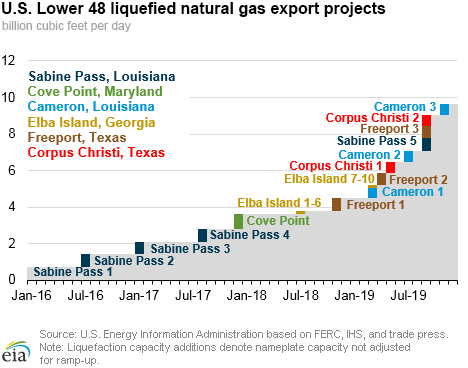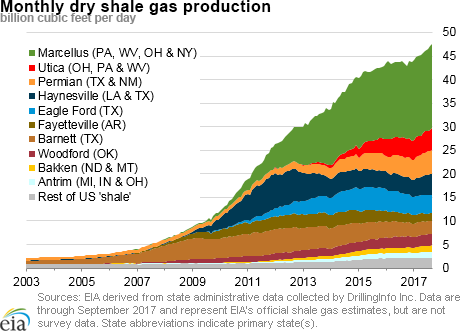In the News:
Sabine Pass Train 4 reaches substantial completion
The recently announced expansion of the Sabine Pass liquefied natural gas (LNG) terminal in Cameron Parish, Louisiana, will add to the rapid growth expected in LNG export capacity for the United States under construction through 2019. The fourth natural gas liquefaction unit—referred to in the industry as a train—at the Sabine Pass LNG terminal is substantially completed, according to an October 13 announcement by Cheniere Energy, Inc., which owns and operates the facility. Train 4 has the capacity to liquefy 0.7 billion cubic feet of natural gas per day (Bcf/d). Cheniere expects to begin commercial deliveries from Train 4 in March 2018.
All of Train 4’s capacity has been contracted under 20-year long-term contracts: 0.5 Bcf/d to India’s state-run natural gas company, GAIL (India) Limited, and the remaining volumes to Shell and Cheniere’s global portfolios for trading in the spot LNG markets. GAIL is one of India’s largest LNG importers, with 1.1 Bcf/d of LNG imports in 2017 (44% of India’s total LNG imports).
GAIL’s contract with Cheniere for off-take volumes from Train 4 includes a swap agreement with Swiss trading company Gunvor Group Ltd. Under this agreement, GAIL will purchase 15 LNG cargoes from Gunvor in 2017 for delivery to India, and Gunvor will purchase 10 cargoes from GAIL in 2018 from GAIL’s off-take volume from Sabine Pass Train 4 for trading in the global spot markets. In a form of commercial agreements typical at Sabine Pass, GAIL will pay between $3.00 per million British thermal unit (MMBtu) and $3.50/MMBtu plus 115% of the final settlement price for the New York Mercantile Exchange (Nymex) Henry Hub natural gas futures contract price for the month in which the cargo is scheduled for delivery.
The Sabine Pass LNG terminal began export operations in February 2016 and currently has five trains in service or under construction, each with a capacity of about 0.7 Bcf/d. Trains 1-3 are fully operational, Train 4 is preparing to enter service as announced, and Train 5 is under construction and expected to enter service in August 2019. Train 6 has been approved by the Federal Energy Regulatory Commission (FERC), but has not yet reached a Final Investment Decision and is not yet under construction.
Liquefaction capacity from all U.S. projects currently under construction will expand Lower 48 LNG export capacity by 1.5 Bcf/d in 2017, 0.9 Bcf/d in 2018, and 5.1 Bcf/d in 2019. Once all of these liquefaction projects become operational, the United States will have the third-largest liquefaction capacity in the world at 9.6 Bcf/d, after Australia and Qatar (11.4 Bcf/d and 10 Bcf/d, respectively).
Overview:
(For the Week Ending Wednesday, October 25, 2017)
- Natural gas spot prices rose at most locations this report week (Wednesday, October 18 to Wednesday, October 25). The Henry Hub spot price rose from $2.81 per million British thermal units (MMBtu) last Wednesday to $2.93/MMBtu yesterday.
- At the Nymex, the November 2017 contract price rose 6¢ from $2.854/MMBtu last Wednesday to $2.919/MMBtu yesterday.
- Net injections to working gas totaled 64 billion cubic feet (Bcf) for the week ending October 20. Working natural gas stocks are 3,710 Bcf, which is 5% lower than the year-ago level and 1% lower than the five-year (2012–16) average for this week.
- The natural gas plant liquids composite price at Mont Belvieu, Texas, fell by 5¢, averaging $7.95/MMBtu for the week ending October 25. The price of propane, butane, and isobutane fell by 2%, 1%, and 1%, respectively. The price of natural gasoline rose by 2%. The price of ethane remained flat week over week.
- According to Baker Hughes, for the week ending Friday, October 20, the natural gas rig count decreased by 8 to 177. The number of oil-directed rigs fell by 7 to 736. The total rig count decreased by 15, and it now stands at 913.
Prices/Supply/Demand:
Prices rise at most locations. This report week (Wednesday, October 18 to Wednesday, October 25), the Henry Hub spot price (the U.S. benchmark price for natural gas) rose 12¢ from $2.81/MMBtu last Wednesday to $2.93/MMBtu yesterday, while the average price over the report week decreased by 9¢ compared to the previous week’s average. At the Chicago Citygate, prices increased 27¢ from $2.74/MMBtu last Wednesday to $3.01/MMBtu yesterday, and the weekly average price increased 2¢.
California prices are mixed. The price at SoCal Citygate increased 17¢ from $4.00/MMBtu last Wednesday to $4.17/MMBtu yesterday, and the weekly average price increased by $1.65/MMBtu. Spot prices in Southern California have been volatile during the past week due to outages and much warmer-than-normal weather. Southern California has experienced supply disruptions because of an unplanned outage on Line 235-2 and planned maintenance work on Line 4000—both pipelines on the Southern California Gas (SoCalGas) system—constraining natural gas supplies from the California border to SoCalGas’s North Coastal Zone, where Los Angeles is located. Also, temperatures in Southern California have been much warmer-than-normal, averaging 13 degrees Fahrenheit (°F) higher than NOAA’s 30-year normal (1981–2010). On Monday, temperatures in Southern California tied the second warmest on record. Prices for next-day delivery of natural gas at the SoCal Citygate reached a high of $12.57/MMBtu on Monday, the highest daily average price on record for the hub, according to data from Natural Gas Intelligence.
Prices at PG&E Citygate in Northern California rose 1¢, up from $3.18/MMBtu last Wednesday to $3.19/MMBtu yesterday, while the weekly average price was unchanged.
Northeast prices increase week over week, but weekly averages are mixed. At the Algonquin Citygate, which serves Boston-area consumers, prices went up 33¢ from $2.90/MMBtu last Wednesday to $3.23/MMBtu yesterday, but the weekly average price decreased 21¢. At the Transcontinental Pipeline Zone 6 trading point for New York, prices increased 14¢ from $2.79/MMBtu last Wednesday to $2.93/MMBtu yesterday, and the weekly average price increased 23¢. Prices at both hubs have averaged lower than prices at the Henry Hub over the same time period. Temperatures in Massachusetts and New York both averaged above normal last week and have further increased this week.
Appalachian price movements are mixed. Tennessee Zone 4 Marcellus spot prices decreased 1¢ from $0.81/MMBtu last Wednesday to $0.80/MMBtu, and the weekly average price decreased by 7¢. Prices at Dominion South in northwest Pennsylvania rose 22¢ from $1.01/MMBtu last Wednesday to $1.23/MMBtu yesterday, while the weekly average price increased by 5¢. Natural gas prices at Dominion South have been trading much lower than the Henry Hub price. Last week the weekly average discount was $2.19/MMBtu, and this week the discount was $2.06/MMBtu.
Supply increases. According to data from PointLogic Energy, the average total supply of natural gas rose by 1% compared with the previous week. Dry natural gas production grew by 1% compared with the previous report week. Average net imports from Canada increased by 2% from last week.
Overall demand decreases. Total U.S. consumption of natural gas fell by 1% compared with the previous report week, according to data from PointLogic Energy. Natural gas consumed for power generation declined by 6% week over week. Industrial sector consumption increased by 1% week over week. In the residential and commercial sectors, consumption increased by 6%. Natural gas exports to Mexico decreased 1%.
U.S. LNG exports increase. Natural gas pipeline deliveries to the Sabine Pass liquefaction terminal exceeded 3 Bcf/d last week, above the 2.8 Bcf/d nameplate capacity of Trains 1–4. Six LNG vessels (LNG-carrying capacity 21.4 Bcf) departed the Sabine Pass terminal last week (Thursday to Wednesday), and one vessel (LNG-carrying capacity 3.8 Bcf) was loading at the terminal on Wednesday. LNG exports to date in October set a new record with 19 loaded vessels, exceeding the previous record set in May with 18 exported cargoes.
Storage:
Weekly net injections fall short of the five-year average. Net injections into storage totaled 64 Bcf for the week ending October 20, compared with the five-year (2012–16) average net injection of 75 Bcf and last year's net injections of 74 Bcf during the same week. Decreased power demand for natural gas contributed to increased net injections compared with the previous report week. Net injections into storage were lower than the five-year average in all regions except the Midwest region. The South Central region accounted for most of the shortfall compared with the five-year average for the week, with net injections totaling 24 Bcf, or 7 Bcf lower than the five-year average net injection. Working gas stocks total 3,710 Bcf, which is 46 Bcf less than the five-year average and 189 Bcf less than last year at this time.
Working gas stocks are poised to end the refill season lower than the five-year average. So far during the 2017 refill season, net injections into storage are 16% lower than the comparable five-year average—1,659 Bcf during the 2017 refill season compared with the five-year average increase of 1,970 Bcf. If net injections continue at 16% lower than the five-year average for the remaining three weeks, working gas stocks will reach 3,782 Bcf by the end of the refill season. Working gas stocks will total 3,796 Bcf if net injections into working gas match the five-year average for the remainder of the refill season.
The January 2018 futures price trades at a discount compared with the current spot price. During the most recent storage week, the average natural gas spot price at the Henry Hub was $2.88/MMBtu, while the Nymex futures price of natural gas for delivery in January 2018 averaged $3.24/MMBtu, a difference of 36¢. The average natural gas spot price at the Henry Hub was 5¢ lower than the front-month futures price at the Nymex. A year ago, the spot price was 6¢ lower than the front-month contract.
The reported net implied flows into storage are close to analysts’ expectations as the October futures contract is due to expire. According to the Desk survey of natural gas analysts, estimates of net injections into working natural gas storage ranged from 61 Bcf to 70 Bcf with a median of 65 Bcf. Prices for the futures contract for November delivery, which is due to expire on October 27, rose about 2¢/MMBtu to $2.91/MMBtu in light trading at the release of the Weekly Natural Gas Storage Report (WNGSR). The price of the contract for December delivery, which is due to become the prompt month on the expiration of the November contract, rose about 1¢/MMBtu to $3.07/MMBtu, with 483 trades executed at the release. Prices declined somewhat in subsequent trading, averaging roughtly $3.05/MMBtu.
Temperatures decline on the week and remain higher than normal in most regions. Temperatures in the Lower 48 states averaged 61°F, 4°F higher than the normal and 4°F lower than last year at this time. During the prior report week ending October 12, temperatures averaged 66°F.
See also:
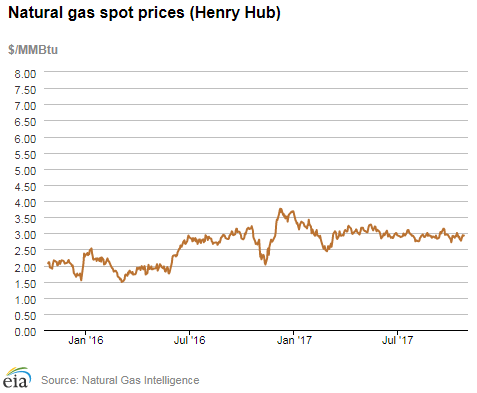
| Spot Prices ($/MMBtu) | Thu, 19-Oct |
Fri, 20-Oct |
Mon, 23-Oct |
Tue, 24-Oct |
Wed, 25-Oct |
|---|---|---|---|---|---|
| Henry Hub |
2.81 |
2.77 |
2.94 |
2.92 |
2.93 |
| New York |
2.47 |
1.66 |
2.88 |
2.92 |
2.93 |
| Chicago |
2.72 |
2.64 |
2.98 |
3.02 |
3.01 |
| Cal. Comp. Avg.* |
2.81 |
2.81 |
3.37 |
3.09 |
3.04 |
| Futures ($/MMBtu) | |||||
| November Contract | 2.989 |
3.000 |
2.946 |
2.962 |
2.854 |
| December Contract |
3.086 |
3.113 |
3.156 |
3.135 |
3.082 |
| *Avg. of NGI's reported prices for: Malin, PG&E Citygate, and Southern California Border Avg. | |||||
| Source: NGI's Daily Gas Price Index | |||||
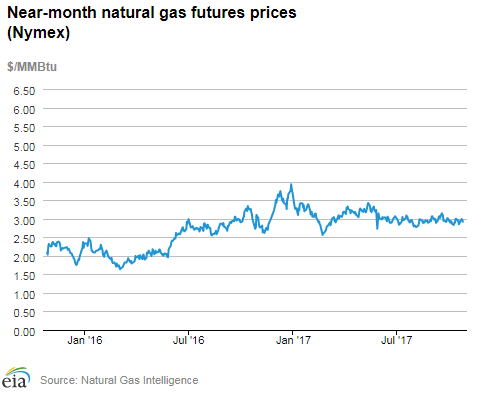
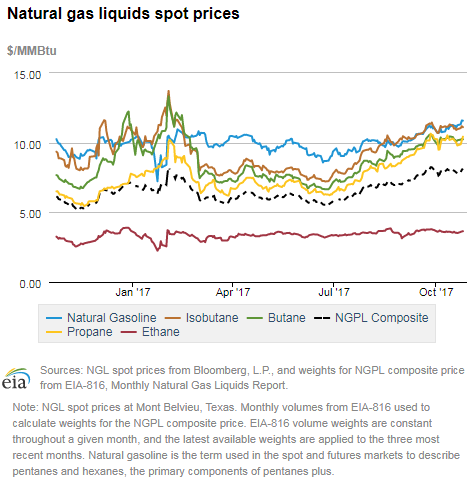
| U.S. natural gas supply - Gas Week: (10/19/17 - 10/25/17) | |||
|---|---|---|---|
Average daily values (Bcf/d): |
|||
this week |
last week |
last year |
|
| Marketed production | 83.2 |
82.2 |
79.1 |
| Dry production | 74.6 |
73.7 |
70.5 |
| Net Canada imports | 5.8 |
5.7 |
6.0 |
| LNG pipeline deliveries | 0.0 |
0.0 |
0.3 |
| Total supply | 80.4 |
79.4 |
76.8 |
|
Source: OPIS PointLogic Energy, an IHS Company | |||
| U.S. natural gas consumption - Gas Week: (10/19/17 - 10/25/17) | |||
|---|---|---|---|
Average daily values (Bcf/d): |
|||
this week |
last week |
last year |
|
| U.S. consumption | 56.4 |
57.1 |
57.0 |
| Power | 23.8 |
25.3 |
24.5 |
| Industrial | 20.1 |
20.0 |
19.9 |
| Residential/commercial | 12.4 |
11.8 |
12.6 |
| Mexico exports | 4.3 |
4.3 |
4.2 |
| Pipeline fuel use/losses | 6.2 |
6.3 |
6.2 |
| LNG pipeline receipts | 3.0 |
3.0 |
0.2 |
| Total demand | 69.9 |
70.6 |
67.6 |
|
Source: OPIS PointLogic Energy, an IHS Company | |||
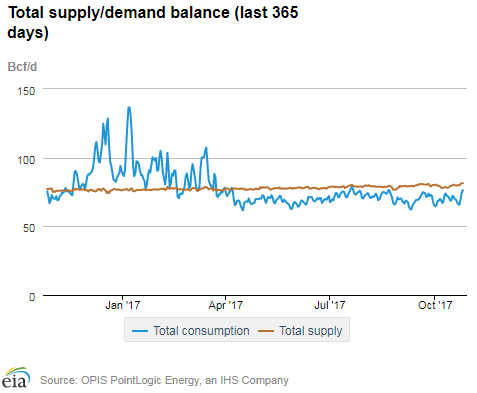
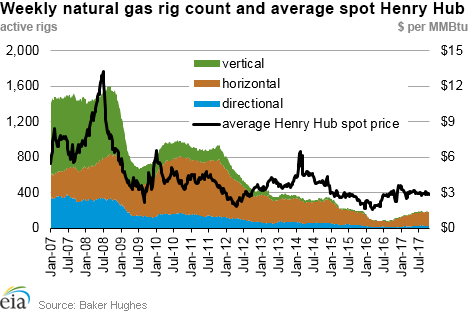
| Rigs | |||
|---|---|---|---|
Fri, October 20, 2017 |
Change from |
||
last week |
last year |
||
| Oil rigs | 736 |
-0.9% |
66.1% |
| Natural gas rigs | 177 |
-4.3% |
63.9% |
| Note: Excludes any miscellaneous rigs | |||
| Rig numbers by type | |||
|---|---|---|---|
Fri, October 20, 2017 |
Change from |
||
last week |
last year |
||
| Vertical | 62 |
-1.6% |
8.8% |
| Horizontal | 771 |
-1.9% |
73.3% |
| Directional | 80 |
1.3% |
56.9% |
| Source: Baker Hughes Inc. | |||
| Working gas in underground storage | ||||
|---|---|---|---|---|
Stocks billion cubic feet (Bcf) |
||||
| Region | 2017-10-20 |
2017-10-13 |
change |
|
| East | 915 |
902 |
13 |
|
| Midwest | 1,082 |
1,054 |
28 |
|
| Mountain | 224 |
224 |
0 |
|
| Pacific | 315 |
316 |
-1 |
|
| South Central | 1,174 |
1,150 |
24 |
|
| Total | 3,710 |
3,646 |
64 |
|
| Source: U.S. Energy Information Administration | ||||
| Working gas in underground storage | |||||
|---|---|---|---|---|---|
Historical comparisons |
|||||
Year ago (10/20/16) |
5-year average (2012-2016) |
||||
| Region | Stocks (Bcf) |
% change |
Stocks (Bcf) |
% change |
|
| East | 937 |
-2.3 |
911 |
0.4 |
|
| Midwest | 1,112 |
-2.7 |
1,065 |
1.6 |
|
| Mountain | 245 |
-8.6 |
216 |
3.7 |
|
| Pacific | 326 |
-3.4 |
356 |
-11.5 |
|
| South Central | 1,279 |
-8.2 |
1,208 |
-2.8 |
|
| Total | 3,899 |
-4.8 |
3,756 |
-1.2 |
|
| Source: U.S. Energy Information Administration | |||||
| Temperature – heating & cooling degree days (week ending Oct 19) | ||||||||
|---|---|---|---|---|---|---|---|---|
HDD deviation from: |
CDD deviation from: |
|||||||
| Region | HDD Current |
normal |
last year |
CDD Current |
normal |
last year |
||
| New England | 67 |
-35 |
30 |
0 |
0 |
-5 |
||
| Middle Atlantic | 56 |
-35 |
15 |
1 |
0 |
-8 |
||
| E N Central | 53 |
-42 |
20 |
2 |
1 |
-13 |
||
| W N Central | 69 |
-24 |
13 |
3 |
1 |
-11 |
||
| South Atlantic | 31 |
-18 |
20 |
39 |
13 |
-11 |
||
| E S Central | 34 |
-14 |
28 |
17 |
6 |
-27 |
||
| W S Central | 17 |
-1 |
15 |
43 |
15 |
-38 |
||
| Mountain | 80 |
-11 |
31 |
17 |
6 |
1 |
||
| Pacific | 20 |
-15 |
-5 |
14 |
6 |
14 |
||
| United States | 45 |
-24 |
15 |
17 |
6 |
-10 |
||
|
Note: HDD = heating degree day; CDD = cooling degree day Source: National Oceanic and Atmospheric Administration | ||||||||
Average temperature (°F)
7-Day Mean ending Oct 19, 2017
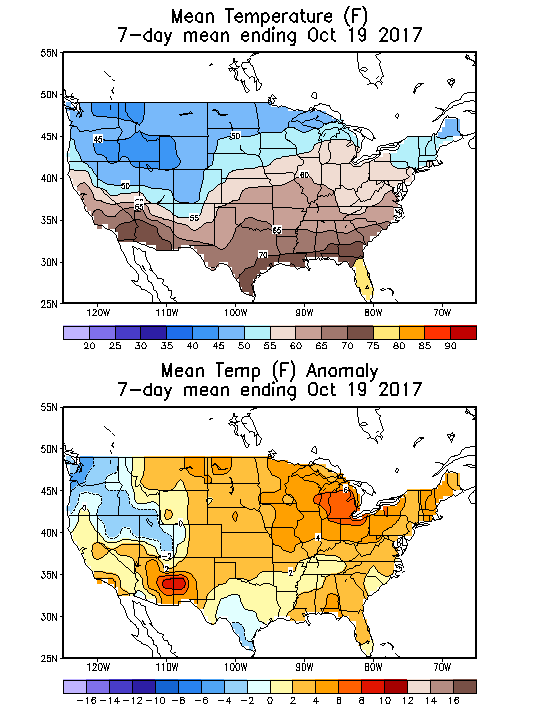
Source: NOAA National Weather Service
Deviation between average and normal (°F)
7-Day Mean ending Oct 19, 2017

Source: NOAA National Weather Service

